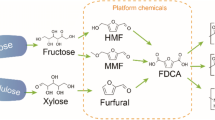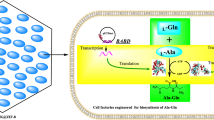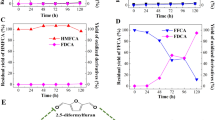Abstract
2,5-Furandicarboxylic acid (FDCA) is a potential biorenewable chemical for applications including plastics, polyamides, drugs, etc. The selective biosynthesis of FDCA from 5-hydroxymethylfurfural (HMF) by a specific enzyme poses a great challenge. In this study, we reported an efficient strategy to produce FDCA from HMF by the tandem biocatalysis of laccase (CotA-TJ102@UIO-66-NH2) and Novozym 435. For the first step, a nanoparticle metal–organic framework was synthesized as a carrier to immobilize CotA-TJ102@UIO-66-NH2, which was assigned for the production of 5-formyl-2-furancarboxylic acid (FFCA) and featured an enzyme loading of 255.54 mg/g, specific activity of 135.90 U/mg, and solid loading ratio of 99.65%. Under optimal conditions, an ideal FFCA yield of 98.5% was achieved, and the CotA-TJ102@UIO-66-NH2 presented a high recycling capacity after 10 cycles. For the second step, Novozym 435 was applied for the further conversion of FFCA into FDCA, presenting a high FDCA yield of 95.5% under the optimized conditions. Novozym 435 also exhibited a high recyclability after eight cycles. As a result, the tandem biocatalysis strategy provided a 94.2% FDCA yield from HMF, indicating its excellence as a method for FDCA production.









Similar content being viewed by others
References
Liu DJ, Chen EYX (2014) Integrated catalytic process for biomass conversion and upgrading to C12 furoin and alkane fuel. ACS Catal 4(5):1302–1310
Casoni AI, Hoch PM, Volpe MA et al (2018) Catalytic conversion of furfural from pyrolysis of sunflower seed hulls for producing bio-based furfuryl alcohol. J Clean Prod 178:237–246
Jaafari L, Ibrahim H, Jaffary B et al (2019) Catalytic production of furfural by pressurized liquid water liquefaction of flax straw. Renew Energy 130:1176–1184
Li HL, Deng AJ, Ren JL et al (2014) Catalytic hydrothermal pretreatment of corncob into xylose and furfural via solid acid catalyst. Bioresour Technol 158:313–320
Ren SJ, Lei HW, Wang L et al (2012) Microwave torrefaction of Douglas fir sawdust pellets. Energy Fuels 26(9):5936–5943
Wang Q, Hou W, Li S et al (2017) Hydrophilic mesoporous poly(ionic liquid)-supported Au–Pd alloy nanoparticles towards aerobic oxidation of 5-hydroxymethylfurfural to 2,5-furandicarboxylic acid under mild conditions. Green Chem 19(16):3820–3830
Qin YZ, Li YM, Zong MH et al (2015) Enzyme-catalyzed selective oxidation of 5-hydroxymethylfurfural (HMF) and separation of HMF and 2,5-diformylfuran using deep eutectic solvents. Green Chem 17(7):3718–3722
Buonerba A, Impemba S, Litta AD et al (2018) Aerobic oxidation and oxidative esterification of 5-hydroxymethylfurfural by gold nanoparticles supported on nanoporous polymer host matrix. Chemsuschem 11(18):3139–3149
Nguyen CV, Liao YT, Kang TC et al (2016) A metal-free, high nitrogen-doped nanoporous graphitic carbon catalyst for an effective aerobic HMF-to-FDCA conversion. Green Chem 18(22):5957–5961
Dick GR, Frankhouser AD, Banerjee A et al (2017) A scalable carboxylation route to furan-2,5-dicarboxylic acid. Green Chem 19(13):2966–2972
Wang F, Zhang ZH (2017) Cs-substituted tungstophosphate-supported ruthenium nanoparticles: an effective catalyst for the aerobic oxidation of 5-hydroxymethylfurfural into 5-hydroxymethyl-2-furancarboxylic acid. J Taiwan Inst Chem Eng 70:1–6
Moreau C, Belgacem MN, Gandini A (2004) Recent catalytic advances in the chemistry of substituted furans from carbohydrates and in the ensuing polymers. Top Catal 27(1–4):11–30
Gandini A, Silvestre AJD, Neto CP et al (2009) The furan counterpart of poly(ethylene terephthalate): an alternative material based on renewable resources. J Polym Sci A Polym Chem 47(1):295–298
Zhu JH, Cai JL, Xie WC et al (2013) Poly(butylene 2,5-furan dicarboxylate), a biobased alternative to PBT: synthesis, physical properties, and crystal structure. Macromolecules 46(3):796–804
Vilela C, Sousa AF, Fonseca AC et al (2014) The quest for sustainable polyesters—insights into the future. Polym Chem 5(9):3119–3141
Yang ZZ, Qi W, Su RX et al (2017) Selective synthesis of 2,5-diformylfuran and 2,5-furandicarboxylic acid from 5-hydroxymethylfurfural and fructose catalyzed by magnetically separable catalysts. Energy Fuels 31(1):533–541
Antonyraj CA, Huynh NTT, Park SK et al (2017) Basic anion-exchange resin (AER)-supported Au-Pd alloy nanoparticles for the oxidation of 5-hydroxymethyl-2-furfural (HMF) into 2, 5-furan dicarboxylic acid (FDCA). Appl Catal A Gen 547:230–236
Xia HA, An JH, Hong M et al (2019) Aerobic oxidation of 5-hydroxymethylfurfural to 2, 5-difurancarboxylic acid over Pd-Au nanoparticles supported on Mg-Al hydrotalcite. Catal Today 319:113–120
Saha B, Dutta S, Abu-Omar MM (2012) Aerobic oxidation of 5-hydroxylmethylfurfural with homogeneous and nanoparticulate catalysts. Catal Sci Technol 2(1):79–81
Mei N, Liu B, Zheng JD et al (2015) A novel magnetic palladium catalyst for the mild aerobic oxidation of 5-hydroxymethylfurfural into 2, 5-furandicarboxylic acid in water. Catal Sci Technol 5(6):3194–3202
Han XW, Li CQ, Liu XH et al (2017) Selective oxidation of 5-hydroxymethylfurfural to 2, 5-furandicarboxylic acid over MnOx–CeO2 composite catalysts. Green Chem 19(4):996–1004
Gao TY, Yin YX, Fang WH et al (2018) Highly dispersed ruthenium nanoparticles on hydroxyapatite as selective and reusable catalyst for aerobic oxidation of 5-hydroxymethylfurfural to 2, 5-furandicarboxylic acid under base-free conditions. Mol Catal 450:55–64
Gao TY, Chen J, Fang WH et al (2018) Ru/MnXCe1OY catalysts with enhanced oxygen mobility and strong metal-support interaction: exceptional performances in 5-hydroxymethylfurfural base-free aerobic oxidation. J Catal 368:53–68
Braun M, Antonietti M (2017) A continuous flow process for the production of 2, 5-dimethylfuran from fructose using (non-noble metal based) heterogeneous catalysis. Green Chem 19(16):3813–3819
Insyani R, Verma D, Kim SM et al (2017) Direct one-pot conversion of monosaccharides into high-yield 2,5-dimethylfuran over a multifunctional Pd/Zr-based metal–organic framework@sulfonated graphene oxide catalyst. Green Chem 19(11):2482–2490
D’Acunzo F, Baiocco P, Fabbrini M et al (2002) A mechanistic survey of the oxidation of alcohols and ethers with the enzyme laccase and its mediation by TEMPO. Eur J Org Chem 24:4195–4201
McKenna SM, Mines P, Law P et al (2017) The continuous oxidation of HMF to FDCA and the immobilisation and stabilisation of periplasmic aldehyde oxidase (PaoABC). Green Chem 19(19):4660–4665
Koopman F, Wierckx N, de Winde JH et al (2010) Identification and characterization of the furfural and 5-(hydroxymethyl)furfural degradation pathways of Cupriavidus basilensis HMF14. Proc Natl Acad Sci 107(11):4919–4924
Dijkman WP, Groothuis DE, Fraaije MW (2014) Enzyme-catalyzed oxidation of 5-hydroxymethylfurfural to furan-2,5-dicarboxylic acid. Angew Chem Int Ed 53(25):6515–6518
Wang KF, Liu CL, Sui KY et al (2018) Efficient catalytic oxidation of 5-hydroxymethylfurfural to 2, 5-furandicarboxylic acid by magnetic laccase catalyst. ChemBioChem 19(7):654–659
Fan LL, Wang Y, Zhao M et al (2016) Magnetic Ganoderma lucidum spore microspheres: a novel material to immobilize CotA multicopper oxidase for dye decolorization. J Hazard Mater 313:122–129
Wang TN, Lu L, Wang JY et al (2015) Enhanced expression of an industry applicable CotA laccase from Bacillus subtilis in Pichia pastoris by non-repressing carbon sources together with pH adjustment: recombinant enzyme characterization and dye decolorization. Process Biochem 50(1):97–103
Chiplunkar PP, Zhao XM, Tomke PD et al (2018) Ultrasound-assisted lipase catalyzed hydrolysis of aspirin methyl ester. Ultrason Sonochemistry 40:587–593
Jahangiri A, Møller AH, Danielsen M et al (2018) Hydrophilization of bixin by lipase-catalyzed transesterification with sorbitol. Food Chem 268:203–209
Arcens D, Grau E, Grelier S et al (2018) 6-O-glucose palmitate synthesis with lipase: investigation of some key parameters. Mol Catal 460:63–68
Chen Y, Cheong LZ, Zhao JH et al (2019) Lipase-catalyzed selective enrichment of omega-3 polyunsaturated fatty acids in acylglycerols of cod liver and linseed oils: modeling the binding affinity of lipases and fatty acids. Int J Biol Macromol 123:261–268
Patil HS, Jadhav DD, Paul A et al (2018) Lipase catalyzed synthesis of antimicrobial andrographolide derivatives. Data Brief 18:1134–1141
Park S, Doan TTN, Koo YM et al (2018) Ionic liquids as cosolvents for the lipase-catalyzed kinetic resolution of ketoprofen. Mol Catal 459:113–118
Bhushan I, Saraswat R, Gupta P et al (2018) Enantioselective resolution of 2-arylpropionic acid derivatives employing immobilization of lipase from Bacillussubtilis strain Kakrayal_1 (BSK-L). Bioresour Technol 269:581–585
Zeng ZM, Tian LJ, Li Z et al (2015) Whole-cell method for phenol detection based on the color reaction of phenol with 4-aminoantipyrine catalyzed by CotA laccase on endospore surfaces. Biosens Bioelectron 69:162–166
Zhang CY, Chang X, Zhu L et al (2019) Highly efficient and selective production of FFCA from CotA-TJ102 laccase-catalyzed oxidation of 5-HMF. Int J Biol Macromol 128:132–139
Cao SL, Yue DM, Li XH et al (2016) Novel nano/micro-biocatalyst: soybean epoxide hydrolase immobilized on UiO-66-NH2 MOF for efficient biosynthesis of enantipure (R)-1, 2-octanediol in deep eutectic solvents. ACS Sustain Chem Eng 4(6):3586–3595
Huo J, Aguilera-Sigalat J, El-Hankari S et al (2015) Magnetic MOF microreactors for recyclable size-selective biocatalysis. Chem Sci 6(3):1938–1943
Liu X, Qi W, Wang YF et al (2017) A facile strategy for enzyme immobilization with highly stable hierarchically porous metal–organic frameworks. Nanoscale 9(44):17561–17570
Hu JP, Yuan BN, Zhang YM et al (2015) Immobilization of laccase on magnetic silica nanoparticles and its application in the oxidation of guaiacol, a phenolic lignin model compound. RSC Adv 5(120):99439–99447
Krystof M, Pérez-Sánchez M, Domínguez de María P (2013) Lipase-mediated selective oxidation of furfural and 5-hydroxymethylfurfural. ChemSusChem 6(5):826–830
Carboni-Oerlemans C, Domínguez de María P, Tuin B et al (2006) Hydrolase-catalysed synthesis of peroxycarboxylic acids: biocatalytic promiscuity for practical applications. J Biotechnol 126(2):140–151
Berkessel A, Andreae MRM (2001) Efficient catalytic methods for the Baeyer–Villiger oxidation and epoxidation with hydrogen peroxide. Tetrahedron Lett 42(12):2293–2295
Hu YL, Dai LM, Liu DH et al (2018) Rationally designing hydrophobic UiO-66 support for the enhanced enzymatic performance of immobilized lipase. Green Chem 20(19):4500–4506
Gascón V, Carucci C, Jiménez MB et al (2017) Rapid in situ immobilization of enzymes in metal-organic framework supports under mild conditions. ChemCatChem 9(7):1182–1186
Xia GH, Cao SL, Xu P et al (2017) Inside cover: preparation of a nanobiocatalyst by efficiently immobilizing aspergillus Niger lipase onto magnetic metal-biomolecule frameworks (BioMOF). ChemCatChem 9(10):1719
Acknowledgements
This work was supported by the National Key R&D Program of China (No. 2017YFB0306502), the Science Fund for Creative Research Groups (No. 21621004), the Project funded by China Postdoctoral Science Foundation (2019), the Key Project of Tianjin Science and Technology Committee (No. 17YFZCSY01080), and the Program of Beiyang Young Scholar of Tianjin University (2012).
Author information
Authors and Affiliations
Corresponding authors
Electronic supplementary material
Below is the link to the electronic supplementary material.
Rights and permissions
About this article
Cite this article
Chang, X., Zhang, C., Gao, L. et al. Tandem Biocatalysis by CotA-TJ102@UIO-66-NH2 and Novozym 435 for Highly Selective Transformation of HMF into FDCA. Trans. Tianjin Univ. 25, 488–496 (2019). https://doi.org/10.1007/s12209-019-00215-w
Received:
Revised:
Accepted:
Published:
Issue Date:
DOI: https://doi.org/10.1007/s12209-019-00215-w




